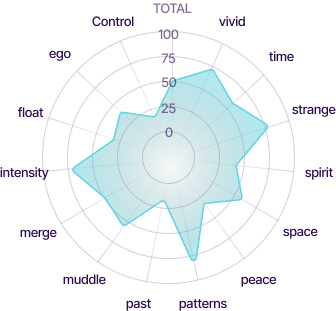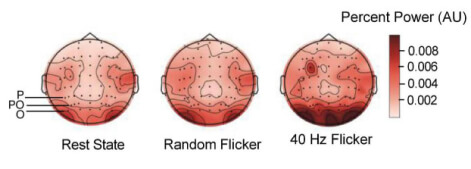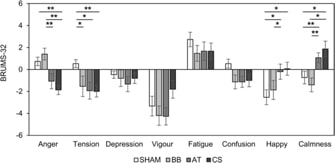Altered states phenomena induced by visual flicker light stimulation Marie Therese Bartossek and Johanna Kemmerer and Timo Torsten Schmidt Department of Education and Psychology, Freie Universität Berlin, Berlin, Germany
Ingredients backed by science.
*From $9.99/moOur approach harnesses the therapeutic powers of Flickering Light Stimulation and sound therapy, proven to significantly enhance mental wellness.
The Role of Flickering Light Stimulation

Flickering Light Stimulation (FLS) utilizes specific light patterns to stimulate brain activity, promoting relaxation and mental clarity. This technology influences neural oscillations and can help synchronize brainwave frequencies to states of deep meditation. Research published in the Journal of Neuroscience has demonstrated that FLS can enhance the connectivity of neural pathways, reducing stress and increasing relaxation (Source).
How Does Flickering Light Stimulation (FLS) Work?

Calmind utilizes your phone's flashlight to evoke a state that mirrors deep meditation and psychedelic experiences. This allows you to deeply immerse yourself in the present, experiencing vivid visuals with your eyes closed and gaining new insights into self-exploration. The flickering light enhances brain connectivity and reduces activity in the default mode network, which is often linked with self-referential thoughts.
The brain functions at various frequencies, from the deep rest of delta waves to the intense focus of gamma waves. Calmind's Flickering Light Stimulation (FLS) aligns with these brain frequencies to modulate brain activity effectively. It does this by using visible light to stimulate the optic nerve, thereby enhancing overall brain function.
What is ASMR and how it affects you
Have you ever felt a certain tingling, relaxing sensation when someone brushed into your arm, or you listened to a particularly good song?
If so, you have experienced ASMR.
The Autonomous Sensory Meridian Response is a physical tingling sensation that begins in your scalp and moves down through the spine to the shoulders.
It is often triggered by an audible stimuli, such as whispering or scratching, though it can also be triggered through physical touch.
Experience mental sensations
Sounds good to you, right?
Could it be even better?
Of course.
Binaural beats + ASMR= B~ASMR
Studies results shown that combination of binaural beats and ASMR could be used for relieving negative emotions and increasing positive emotions for users.
Their findings suggest that this could provide an effective way of improving the quality of sleep, too.
Get Started
SHAM = sham condition, BB = binaural beats, AT = autonomous sensory meridian response triggers, CS = combined stimuli of BB and AT at the ratio of 30:60 dB. ∗<0.05 with no correction, ∗∗<0.05 with Bonferroni correction.
souce: https://www.ncbi.nlm.nih.gov/pmc/articles/PMC6900908/

Scientific Studies
Flicker light stimulation induces thalamocortical hyperconnectivity with LGN and higher-order thalamic nuclei Ioanna A. Amaya, Marianna E. Schmidt, Marie T. Bartossek, Johanna Kemmerer, Evgeniya Kirilina, Till Nierhaus, Timo T. Schmid Imaging Neuroscience (2023) 1: 1–20.
Flicker light stimulation enhances the emotional response to music: a comparison study to the effects of psychedelics Caspar Montgomery and Ioanna Alicia Amaya and Timo Torsten SchmidtBerlin School of Mind and Brain, Humboldt-Universität zu Berlin, Berlin, Germany
Optimal flickering light stimulation for entraining gamma waves in the human brain Kanghee Lee, Yeseung Park, Seung Wan Suh, Sang-Su Kim, Do-Won Kim, Jaeho Lee, Jaehyeok Park, Seunghyup Yoo & Ki Woong KimScientific Reports volume 11, Article number: 16206 (2021)
Effect of frequency and rhythmicity on flicker light-induced hallucinatory phenomena Ioanna Alicia Amaya,Nele Behrens,David John Schwartzman,Trevor Hewitt,Timo Torsten Schmidt PLoS ONE 18(4): e0284271. https://doi.org/10.1371/journal.pone.0284271
40 Hz light flickering promotes sleep through cortical adenosine signaling Xuzhao Zhou, Yan He, Tao Xu, Zhaofa Wu, Wei Guo, Xi Xu, Yuntao Liu, Yi Zhang, Huiping Shang, Libin Huang, Zhimo Yao, Zewen Li, Lingya Su, Zhihui Li, Tao Feng, Shaomin Zhang, Olivia Monteiro, Rodrigo A. Cunha, Zhi-Li Huang, Kang Zhang, Yulong Li, Xiaohong Cai, Jia Qu & Jiang-Fan Chen
Cell Research volume 34, pages214–231 (2024)
40 Hz Light Flicker Promotes Learning and Memory via Long Term Depression in Wild-Type Mice Tian Tian 1, Xin Qin 2, Yali Wang 3, Yan Shi 4, Xin Yang 1PMID: 34602491 DOI: 10.3233/JAD-215212
Visual light flicker stimulation: enhancing alertness in sleep-deprived rats
Kun Wang, Kang Chen, Zilin Wei, Tianhui Wang, Aili Wei, Xiujie Gao, Yingkai Qin, Yingwen Zhu, Yi Ge, Bo Cui, Mengfu Zhu
Military Medical Sciences Academy, Tianjin, China
Why visual stimulation may work against Alzheimer’s
Anne Trafton | MIT News Office
Article
Light and sound therapy for Alzheimer’s may also prevent ‘chemo brain’
By Clare Wilson
Article
Flashing And Strobe Light Therapy For Alzheimer’s And Dementia Disease
By Christopher Ravn
Article
Brain Responses to a 6-Hz Binaural Beat: Effects on General Theta Rhythm and Frontal Midline Theta Activity Nantawachara Jirakittayakorn and Yodchanan Wongsawat Brain-Computer Interface Laboratory, Department of Biomedical Engineering, Faculty of Engineering, Mahidol University, Nakhorn Pathom, Thailand – PMID: 28701912
Use of Binaural Beat Tapes for Treatment of Anxiety: A Pilot Study of Tape Preference and Outcomes R P Le Scouarnec, R M Poirier, J E Owens, J Gauthier, A G Taylor, P A Foresman, Clinique Psyché in Montreal, Quebec. PMID: 11191043
Binaural Beat Technology in Humans: A Pilot Study to Assess Psychologic and Physiologic Effects Helané Wahbeh, Carlo Calabrese, Heather Zwickey, Helfgott Research Institute, National College of Natural Medicine, Portland. PMID: 17309374
Auditory Beat Stimulation and its Effects on Cognition and Mood States
Leila Chaieb, Elke Caroline Wilpert, Thomas P. Reber, and Juergen Fell Department of Epileptology, University of Bonn , Bonn , Germany. PMID: 26029120
Efficacy of Theta Binaural Beats for the Treatment of Chronic Pain Donna D Zampi, PMID: 26773319
Binaural Auditory Beats Affect Long-Term Memory Miguel Garcia-Argibay, Miguel A Santed, José M Reales Department of Behavioral Science, National University of Distance Education (UNED), Juan del Rosal, 10, 28040, Madrid, Spain. PMID: 29222722
Binaural Beats Through the Auditory Pathway: From Brainstem to Connectivity Patterns Hector D Orozco Perez, Guillaume Dumas, Alexandre Lehmann Laboratory for Brain, Music and Sound Research (BRAMS), Montreal H2V 2S9, Canada. PMID: 32066611
More attentional focusing through binaural beats: evidence from the global–local task Lorenza S. Colzato, Hayley Barone, Roberta Sellaro, and Bernhard Hommel Cognitive Psychology Unit, Institute for Psychological Research and Leiden Institute for Brain and Cognition, Leiden University, Wassenaarseweg 52, 2333 AK Leiden, The Netherlands. PMID: 26612201
The Effect of Binaural Beats on Visuospatial Working Memory and Cortical Connectivity
Christine Beauchene, Nicole Abaid, Rosalyn Moran, Rachel A. Diana, and Alexander Leonessa Center for Dynamic Systems Modeling and Control, Department of Mechanical Engineering, Virginia Polytechnic Institute and State University, Blacksburg, Virginia, United States of America. PMID: 27893766
The Effects of Binaural and Monoaural Beat Stimulation on Cognitive Functioning in Subjects with Different Levels of Emotionality Hessel Engelbregt, Nora Meijburg, Marjolein Schulten, Oliver Pogarell, and Jan Berend Deijen Hersencentrum Mental Health Institute, Amsterdam, The Netherlands. PMID: 32395188
A Novel Insight of Effects of a 3-Hz Binaural Beat on Sleep Stages During Sleep Nantawachara Jirakittayakorn and Yodchanan Wongsawat Brain Computer Interface Laboratory, Department of Biomedical Engineering, Faculty of Engineering, Mahidol University, Salaya, Thailand. PMID: 30319382
Possible Effect of Binaural Beat Combined With Autonomous Sensory Meridian Response for Inducing Sleep Minji Lee,Chae-Bin Song, Gi-Hwan Shin, and Seong-Whan Lee
Department of Brain and Cognitive Engineering, Korea University, Seoul, South Korea. PMID: 31849629
More than a feeling: Autonomous sensory meridian response (ASMR) is characterized by reliable changes in affect and physiology Giulia Lara Poerio, Emma Blakey, Thomas J. Hostler, Theresa Veltri Department of Psychology, University of Sheffield, Sheffield, United Kingdom. PMID: 29924796
Autonomous Sensory Meridian Response (ASMR): a flow-like mental state Emma L. Barratt and Nick J. Davis Department of Psychology, Swansea University, Swansea, United Kingdom. PMID: 25834771
Expectancy effects in the Autonomous Sensory Meridian Response Daniella K. Cash, Laura L. Heisick, and Megan H. Papesh Department of Psychology, Louisiana State University and Agricultural and Mechanical College, Baton Rouge, LA, USA. PMID: 30155346
Mindfulness and autonomous sensory meridian response (ASMR) Beverley K. Fredborg, James M. Clark, and Stephen D. Smith Department of Psychology, Ryerson University, Toronto, ON, Canada. PMID: 30123716
An Examination of Personality Traits Associated with Autonomous Sensory Meridian Response (ASMR) Beverley Fredborg, Jim Clark, and Stephen D. Smith Department of Psychology, University of Winnipeg, Winnipeg, MB, Canada. PMID: 28280478
Sensory determinants of the autonomous sensory meridian response (ASMR): understanding the triggers Emma L. Barratt, Charles Spence, and Nick J. Davis Department of Experimental Psychology, University of Oxford, Oxford, UK. PMID: 29018601
A functional magnetic resonance imaging investigation of the autonomous sensory meridian response Stephen D. Smith, Beverley K. Fredborg, and Jennifer Kornelsen Department of Psychology, University of Winnipeg, Winnipeg, MB, Canada. PMID: 31275748
Atypical Functional Connectivity Associated with Autonomous Sensory Meridian Response: An Examination of Five Resting-State Networks Stephen D. Smith, Beverley Katherine Fredborg, and Jennifer Kornelsen Department of Psychology, University of Winnipeg, Winnipeg, Canada. PMID: 30931592
Sleep Health: Can We Define It? Does It Matter? Daniel J. Buysse, MD
Sleep Medicine Institute and Department of Psychiatry, School of Medicine, University of Pittsburgh, Pittsburgh, PA. PMID: 24470692
Music as a sleep aid in fibromyalgia Larry M Picard, Lee R Bartel, Allan S Gordon, Davor Cepo, Qi Wu, and Leah R Pink Music and Health Research Collaboratory, University of Toronto, Toronto, Ontario. PMID: 24555178
Possible Effect of Binaural Beat Combined With Autonomous Sensory Meridian Response for Inducing Sleep Minji Lee,Chae-Bin Song, Gi-Hwan Shin, and Seong-Whan Lee Department of Brain and Cognitive Engineering, Korea University, Seoul, South Korea. PMID: 31849629
The Relative Impact of Sleep and Circadian Drive on Motor Skill Acquisition and Memory Consolidation Matthew A. Tucker, Christopher J. Morris, PhD, Alexandra Morgan, Jessica Yang, Samantha Myers, Joanna Garcia Pierce, Robert Stickgold, and Frank A. J. L. Scheer, Center for Sleep and Cognition, Beth Israel Deaconess Medical Center, Boston, MA. PMID: 28460138
Sleep deprivation: Impact on cognitive performance Paula Alhola and Päivi Polo-Kantola Department of Psychology. PMID: 19300585
Sleep and obesity Guglielmo Beccutia, and Silvana Pannaina Department of Medicine, University of Chicago, Chicago, USA. PMID: 21659802
Sleep and anxiety disorders Luc Staner Sleep Laboratory, FORENAP, Rouffach, France. PMID: 22033804
Cumulative Sleepiness, Mood Disturbance, and Psychomotor Vigilance Performance Decrements During a Week of Sleep Restricted to 4-5 Hours Per Night D F Dinges, F Pack, K Williams, K A Gillen, J W Powell, G E Ott, C Aptowicz, A I Pack Department of Psychiatry, University of Pennyslvania School of Medicine, Philadelphia 19104-6021, USA. PMID: 9231952
Midday napping in children: associations between nap frequency and duration across cognitive, positive psychological well-being, behavioral, and metabolic health outcomes Jianghong Liu,Rui Feng, Xiaopeng Ji, Naixue Cui, Adrian Raine, and Sara C Mednick Department of Family and Community Health, University of Pennsylvania School of Nursing, Philadelphia, PA. PMID: 31135911
The impact of frequent napping and nap practice on sleep-dependent memory in humans Elizabeth A. McDevitt, Negin Sattari, Katherine A. Duggan, Nicola Cellini… Department of Psychology, University of California, Riverside, Riverside, CA 92521 USA. PMID: 30305652
About Sleep’s Role in Memory Björn Rasch and Jan Born Division of Biopsychology, Neuroscience Center Zurich and Zurich Center for Integrative Human Physiology. PMID: 23589831
Goodnight book: sleep consolidation improves word learning via storybooks Sophie E. Williams and Jessica S. Horst School of Psychology, University of Sussex, Brighton, UK. PMID: 24624111
Insomnia with objective short sleep duration and risk of incident cardiovascular disease and all-cause mortality: Sleep Heart Health Study Suzanne M Bertisch, Benjamin D Pollock, Murray A Mittleman, Daniel J Buysse, Lydia A Bazzano, Daniel J Gottlieb, and Susan Redline Department of Medicine, Beth Israel Deaconess Medical Center, Boston, MA. PMID: 29522193
Objective Measurements of Energy Balance Are Associated With Sleep Architecture in Healthy Adults Andrea M. Spaeth, David F. Dinges, and Namni Goel Center for Sleep and Circadian Neurobiology, Perelman School of Medicine, University of Pennsylvania, Philadelphia, PA. PMID: 28364451
Mindfulness Training Reduces Stress At Work: A Randomized Controlled Trial Brian Chin, Jerry Slutsky, Julianna Raye, and J. David Creswell
Department of Psychology, Carnegie Mellon University. PMID: 30923585
Mindful Emotion Regulation: Exploring the Neurocognitive Mechanisms behind Mindfulness Alessandro Grecucci, Edoardo Pappaianni, Roma Siugzdaite, Anthony Theuninck, and Remo Job Department of Cognitive Science (DiSCoF), University of Trento, Corso Bettini 84, Rovereto, 38068 Trentino, Italy. PMID: 26137490
Relationship between Meditative Practice and Self-Reported Mindfulness: The MINDSENS
Composite Index Joaquim Soler, Ausiàs Cebolla, Albert Feliu-Soler, Marcelo M. P. Demarzo.. Department of Psychiatry, Hospital de la Santa Creu i Sant Pau, Barcelona, Spain. PMID: 24466175
Six-year positive effects of a mindfulness-based intervention on mindfulness, coping and well-being in medical and psychology students Michael de Vibe, Ida Solhaug, Jan H. Rosenvinge, Reidar Tyssen, … Norwegian Institute of Public Health, Oslo, Norway. PMID: 29689081
Testing the mindfulness-to-meaning theory: Evidence for mindful positive emotion regulation from a reanalysis of longitudinal data Eric L. Garland, Adam W. Hanley, Phillipe R. Goldin, James J. Gross College of Social Work, University of Utah, Salt Lake City, Utah, United States of America. PMID: 29211754
Biobehavioral Mechanisms of Mindfulness as a Treatment for Chronic Stress: An RDoC Perspective Eric L. Garland, Adam W. Hanley, Anne K. Baker, and Matthew O. Howard Center on Mindfulness and Integrative Health Intervention Development (C-MIIND) College of Social Work, University of Utah, Salt Lake City, UT, USA. PMID: 28840198
Effects of Mindfulness-Based Stress Reduction on employees’ mental health: A systematic review Math Janssen, Yvonne Heerkens, Wietske Kuijer, Beatrice van der Heijden. Occupation & Health Research Group, HAN University of Applied Sciences, Nijmegen, the Netherlands. PMID: 29364935
Depression, Mindfulness, and Psilocybin: Possible Complementary Effects of Mindfulness Meditation and Psilocybin in the Treatment of Depression. Kristin Heuschkel and Kim P.C. Kuypers Department of Neuropsychology and Psychopharmacology, Faculty of Psychology and Neuroscience, Maastricht University, Maastricht, Netherlands. PMID: 32296353
Mindfulness and mood stimulate each other in an upward spiral: a mindful walking intervention using experience sampling Rinske A. Gotink, Karlijn S.F.M. Hermans, Nicole Geschwind, Reinier De Nooij, Wouter T. De Groot, and Anne E.M. Speckens Department of Epidemiology, Erasmus MC Rotterdam, Rotterdam, Netherlands. PMID: 27642373
Mind The Hype: A Critical Evaluation and Prescriptive Agenda for Research on Mindfulness and Meditation Nicholas T. Van Dam, Marieke K. van Vugt, David R. Vago,Laura Schmalzl, Clifford D. Saron, Andrew Olendzki, Ted MeissnerDepartment of Psychiatry, Icahn School of Medicine at Mount Sinai, New York, NY, USA. PMID: 29016274
Positive mood broadens visual attention to positive stimuli Heather A. Wadlinger and Derek M. Isaacowitz Department of Psychology, Brandeis University, MS 062, Waltham, MA 02454-9110. PMID: 20431711
Social and Behavioral Predictors of Adolescents’ Positive Attitude towards Life and Self Marta Malinowska-Cieślik, Joanna Mazur, Hanna Nałęcz, and Agnieszka Małkowska-Szkutnik Department of Environmental Health, Faculty of Health Sciences, Jagiellonian University, Medical College, 20 Grzegorzecka Str., 31-531 Krakow, Poland. PMID: 31717962
Happiness Unpacked: Positive Emotions Increase Life Satisfaction by Building Resilience Michael A. Cohn, Barbara L. Fredrickson, Stephanie L. Brown, Joseph A. Mikels, and Anne M. Conway School of Medicine, University of California San Francisco. PMID: 19485613
Positive Emotions Trigger Upward Spirals Toward Emotional Well-Being Barbara L. Fredrickson, Thomas Joiner Department of Psychology, University of Michigan. PMID: 11934003
The Role of Positive Emotions in Positive Psychology Barbara L. Fredrickson Department of Psychology and Research Center for Group Dynamics at the Institute for Social Research, University of Michigan. PMID: 11315248
What Good Are Positive Emotions? Barbara L. Fredrickson University of Michigan. PMID: 21850154
Psychological Resilience and Positive Emotional Granularity: Examining the Benefits of Positive Emotions on Coping and Health Michele M. Tugade, Barbara L. Fredrickson, and Lisa Feldman Barrett Michele M. Tugade at the Department of Psychology, NY. PMID: 15509280
Open Hearts Build Lives: Positive Emotions, Induced Through Loving-Kindness Meditation, Build Consequential Personal Resources Barbara L. Fredrickson, Michael A. Cohn, Kimberly A. Coffey, Jolynn Pek, and Sandra M. Finkel Department of Psychology, University of North Carolina at Chapel Hill. PMID: 18954193
** Research shows all these things contained in Calmind can improve the quality of life.
Hovewer, Calmind is not intended to manage, treat, or cure any medical condition.
Calm your mind with Calmind.
Try for free today.
Multifunctional approach to mind care.
Discover benefits



